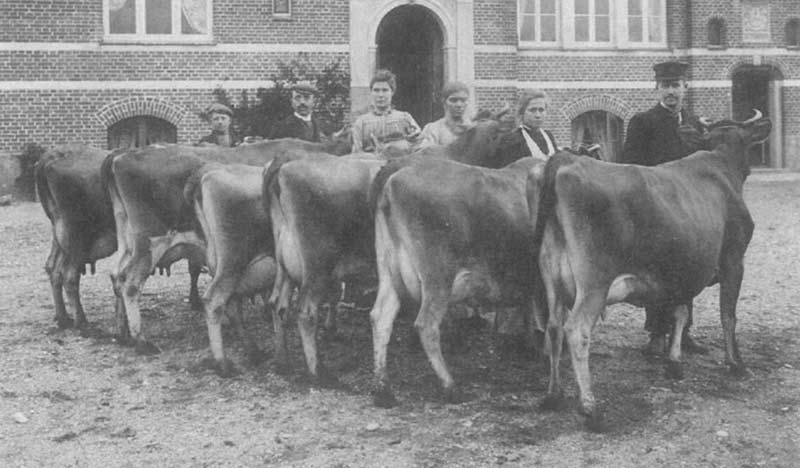Heritage Jersey Organization (501 c3 non-profit) was created to provide a registry and serve as an extension of MaryJane Butters’ Milk Cow Kitchen cow-keeping and cheese-making book.
It was established as a resource to promote the original purpose of the Jersey as a mid-size family milk cow like those found on the Isle of Jersey and elsewhere in the early 1900s.

Circa 1896
Its mission is to encourage ongoing discussions about how to best adapt breeding decisions to promote the breed, while at the same time selecting for the traits that make a “butter cow” (the name given to Jerseys because they produce so much cream). Some cows’ teats are less than desirable, and in some cases, simply too small to milk; or the amount of milk a miniature cow produces won’t be worth the daily effort; or a full-size cow will produce too much milk for a family’s needs. Through proper, long-term registration, strict DNA testing, and the highest possible standard of breeding practices, along with honesty that flows as readily as cream from a Jersey, Heritage Jersey Organization is helping re-establish the unique characteristics of the perfect backyard cow—the heritage Jersey.
Heritage Jersey Today
Heritage Jersey Organization strives to be a place where old and new members can interact and meet others who share their love of the backyard Jersey cow, both for milk and meat production. As a group, members strive to incorporate the highest possible standard of breeding and marketplace practices for the betterment and integrity of the breed. A heritage Jersey is a homestead cow from the past that promises to greatly enhance our future and those of our children and grandchildren.
Long-term Love Affair
MaryJane Butters started her love affair with the idea of a backyard milk cow in 1980 when she milked her cow, Rosie—a Jersey. Sold on the benefits of fresh, unadulterated, bone-building milk (her daughter, born in 1979, has never had a cavity!), Jerseys have been a consistent part of her everyday life.
MaryJane brought home other breeds over the years—Dexter, Angus, and Milking Shorthorn—but she always came back around to the Jersey, and to this day, she still milks a Jersey cow every day.
History of the Jersey
If you search the Internet or speak with historians seeking the history of Jerseys, you’re soon confused. They originated in Africa, not Asia. Maybe they have a Scandinavian influence, or French. Some historic accounts place the Jersey in the U.S. as early as 1657. Hardy in drought and heat conditions, in certain cases, the Jersey cow seems to have more in common with non-European cattle, but given their name, clearly, we think of them as coming from the Isle of Jersey in Great Britain. Early on, MaryJane Butters was new to the concept of buying a “registered” Jersey, so she located a registry that existed for the purpose of registering “backyard” Jerseys—actually, it was a registry for miniature Jerseys, but MaryJane had a mix of sizes already, so she got to wondering what the back story was regarding miniature Jerseys.
At that time, there were several breeders in the U.S. who claimed they owned the direct descendants of the original Jersey from the Isle of Jersey, and for the convenience of a storyline, they said the modern-day miniature Jersey is the original Jersey. But breed standards set up by the Royal Jersey Agricultural Society in 1834 don’t confirm this. And the Jerseys first photographed in the United States weren’t pint-sized, either. They also weren’t the modern-day, full-size Jersey that you see on many large-scale dairies. The Heritage Jersey Organization was formed in order to pay homage to the original mid-size Jersey cow and to create a community of like-minded people.
Size of the Jersey
What exactly is a “commercial” (full-size), mid-size, or miniature Jersey? Through modern-day selective breeding and cross-breeding, we’ve ended up with not only bigger Jerseys, but also miniature and even micro-miniature Jerseys. The miniature Jersey concept seems to have come onto the scene some 20–40 years ago, depending on who’s claiming credit for finding (owning) what they call the “original” Jersey breed. It has brought us some adorable tiny animals, but it has been beset with fraud, arrests, dishonest cross-breeding and record-keeping, intentionally misleading height measurements, and the mismanagement of registries.
Cash Cow
The most efficient dairy breed, Jerseys produce the richest—and the tastiest—milk with over 18% more protein and 20% more calcium compared to the average of all other breeds. Called the “butter cow” because of the amount of butterfat it produces and the efficient way it converts its food into energy (the Jersey carbon footprint is 20% less than that of Holsteins), the Jersey “cash cow” now ranks second in number of dairy cattle in the world. In addition, Texas A & M
University ranked Jersey meat #1 for flavor over well-known “beef” breeds.
Heritage Jersey Organization is fully committed long-term to raising the bar for not only cow care, but also the human relationships that constitute a registry around the resurgence of the ideal backyard cow reminiscent of the iconic, original tether-grazed Jersey cow shown so often with her “cowmom” at the turn of the century—a woman was almost always the keeper of the family cow back then.